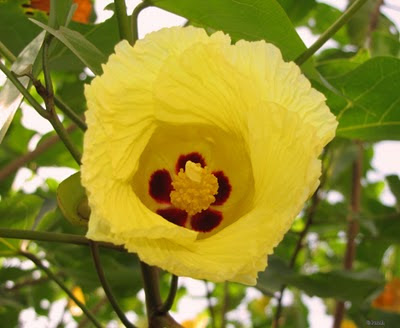Indian Tulip Tree (Thespesia Populnea/भेंड, पारस-पिंपळ) is a marvellous tree which is considered sacred in many countries. It is planted near temples & churches. Its name is derived from a Greek word thespesios which means 'divine'.
The beautiful tree has glossy green, heart-shaped leaves & yellow hibiscus-type flowers which bloom year round. It is interesting to know that these yellow flowers turn dark red, purple or pink as the day progresses. Thus the flower lasts for couple of days. In Tamil, the tree is known as Poovarasu which means 'King of Flowers'..apt name for such a lovely tree! The tree establishes well & grows rapidly. Its branches are closely set & form a dense crown, hence it is also known as Umbrella tree.
Instead of being only a very good ornamental tree, it has a wide range of uses too! And these vary from use in dune stabilization or for medicine to the use as organic mulch. It is a tough tree which can survive the poor drainage & hot, dry conditions common to urban areas.
 Indian Tulip Tree is an excellent species for coastal protection as it tolerates droughty sandy soils, brackish water, occasional water-logging, wind & salt spray. It also provides abundant leaf litter for use as mulch in sandy, coastal sites. The tree firmly anchors sandy soils & protects them from erosion. Hence being a soil improver & stabilizer and a excellent windbreak, it is also used as living fences.
Indian Tulip Tree is an excellent species for coastal protection as it tolerates droughty sandy soils, brackish water, occasional water-logging, wind & salt spray. It also provides abundant leaf litter for use as mulch in sandy, coastal sites. The tree firmly anchors sandy soils & protects them from erosion. Hence being a soil improver & stabilizer and a excellent windbreak, it is also used as living fences.
Its bark produces a strong fibre which is used for ropes, cordage, fishing lines, coffee bags etc. The flowers & its capsule are said to give a yellow dye & the bark produces tannin.
Indian Tulip has been used in many ways in traditional medicines in India. According to Ayurveda, Indian Tulip is astringent, acrid, cooling and is shown to be useful in skin related troubles, leprosy, diseases of blood & urinary system, diarrhoea, dysentry, cholera, diabetes, ascites etc.
Indian Tulip is a relatively easy tree to grow. It propagates easily from seed or from cuttings.
The Indian Tulip is occasionally confused with Sea Hibiscus (Hibiscus Tiliaceus/बेलिपता) due to similar heart-shaped leaves, yellow flowers. Both these trees are, interestingly & shockingly, more or less similar in their uses also. Of course, there are differences in medical properties. But for other aspects, both of the trees can be called as replica of one another.
Sea Hibiscus tree is reputed to be a good forage plant for bees & the time to first flowering is typically 2–3 years of age. Sea Hibiscus has a noted ability to improve soil in organic matter & fertility, most likely through leaf drop & decomposition, which occurs at a moderately fast rate.
The beautiful tree has glossy green, heart-shaped leaves & yellow hibiscus-type flowers which bloom year round. It is interesting to know that these yellow flowers turn dark red, purple or pink as the day progresses. Thus the flower lasts for couple of days. In Tamil, the tree is known as Poovarasu which means 'King of Flowers'..apt name for such a lovely tree! The tree establishes well & grows rapidly. Its branches are closely set & form a dense crown, hence it is also known as Umbrella tree.
Instead of being only a very good ornamental tree, it has a wide range of uses too! And these vary from use in dune stabilization or for medicine to the use as organic mulch. It is a tough tree which can survive the poor drainage & hot, dry conditions common to urban areas.
 Indian Tulip Tree is an excellent species for coastal protection as it tolerates droughty sandy soils, brackish water, occasional water-logging, wind & salt spray. It also provides abundant leaf litter for use as mulch in sandy, coastal sites. The tree firmly anchors sandy soils & protects them from erosion. Hence being a soil improver & stabilizer and a excellent windbreak, it is also used as living fences.
Indian Tulip Tree is an excellent species for coastal protection as it tolerates droughty sandy soils, brackish water, occasional water-logging, wind & salt spray. It also provides abundant leaf litter for use as mulch in sandy, coastal sites. The tree firmly anchors sandy soils & protects them from erosion. Hence being a soil improver & stabilizer and a excellent windbreak, it is also used as living fences. Its bark produces a strong fibre which is used for ropes, cordage, fishing lines, coffee bags etc. The flowers & its capsule are said to give a yellow dye & the bark produces tannin.
Indian Tulip has been used in many ways in traditional medicines in India. According to Ayurveda, Indian Tulip is astringent, acrid, cooling and is shown to be useful in skin related troubles, leprosy, diseases of blood & urinary system, diarrhoea, dysentry, cholera, diabetes, ascites etc.
Indian Tulip is a relatively easy tree to grow. It propagates easily from seed or from cuttings.
Sea Hibiscus tree is reputed to be a good forage plant for bees & the time to first flowering is typically 2–3 years of age. Sea Hibiscus has a noted ability to improve soil in organic matter & fertility, most likely through leaf drop & decomposition, which occurs at a moderately fast rate.

No comments:
Post a Comment